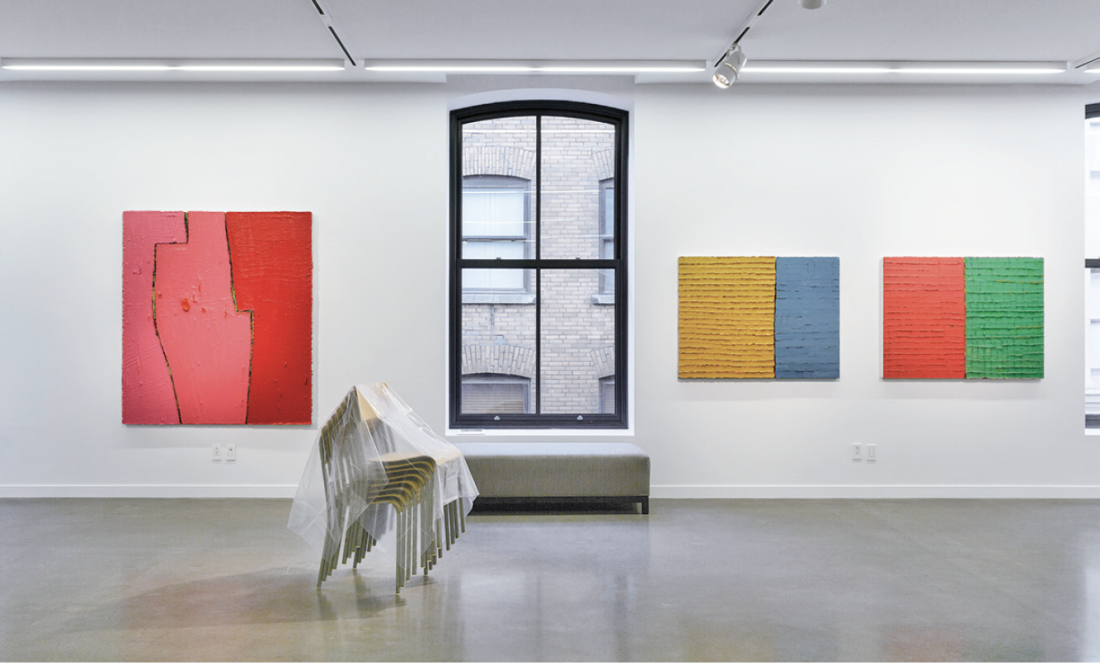“Living in a Material World”
From the moment I entered the Centre PHI exhibition space, I was drawn into the web of an unlikely but edifying dialogue between two artists whose practices, at least upon first inspection, seemed diametrically opposed. The brilliant and gregarious chromatic inventions of Paul Bureau met their match in the subversive monochromal works of Valérie Kolakis. And yet, it was not long before recognizing just how dovetailed the pieces in the exhibition really were: the chromatic integer and the restless object shared conceptual rigour and material force.
Paul Bureau’s paintings, eloquent in their materiality, staked their claim on both body image and optic from the get-go. Paintings like Emergence (P), 2008, and Thrust, 2012, and One on One (B), 2009, possess real somatic weight and presence. The intrinsically tiered construction of colour fields was a processual entity, a congeries of intertwined, labour-leavened strata.
This was particularly true when the artist incised his surfaces, Fontana-like, in order to reveal the secret history of a painting’s nurturing and growth. But whereas Fontana left the flaps of the wound open, inviting the void into painting, Bureau stitched it shut again like a surgeon, only now showing the slow chronology of layer upon layer of applied oil paint in the cicatrices that remained. These excavated layers formed a stratigraphy which unfolded in vertical depth or horizontal distension as each previous layer of the artist’s paint application was revealed.
Bureau’s paintings have little in common with abstract expressionist painting, but one thing they do share with artists like Milton Resnick and Eugène Leroy is a licentious materiality, and the hegemony achieved by the hedonistic act of painting in and through it. The materiality is sensuous and tactual, and in most of the works presented, Bureau makes the process of painting evident, exposing the painterly acts sealed under the final surface. He wants to share stages of painting’s labour, effectively turning his work inside out and securing it as a teaching story.

Installation view “Living in a Material World.” Front: Valérie Kolakis, Untitled (Chairs), 2012, 8 chairs and plastic sheet. Back from left to right: Paul Bureau, Emergence (P), 2008, oil on canvas, 160 x 142 cm. Paul Bureau, Surfaces 10-11, 2001, oil on wood, 91 x 122 cm. Paul Bureau, Surfaces, 2001, oil on wood, 91 x 122 cm. Photograph: Guy L’Heureux, courtesy Donald Browne Gallery.
In a recent monograph on the artist, I wrote that his oil paintings are finally, provocations. They incite questioning, self-reflection—and contemplation. Kolakis’s works are also provocative and disruptive. She explodes the assumptive contexts that surround seemingly ordinary objects with conceptual TNT, élan and understatement. Mounting the staircase into the exhibition space, I noted the wall directly in front of the staircase had a mirror on it. An iron rope hanging from the ceiling bifurcated the mirror. The reflection in the mirror made the making of Lacanian meaning complicit with the viewer. Her work is rife with such seamless binaries.
Whereas Bureau digs out test pits in his paintings to open an archaeological window on their making, Kolakis works the conceptual flip side, offering up enigmatic objects that seem to be artefacts secured from such sites and preserved intact.
Consider, in this regard, the stack of wooden chairs covered in plastic in the middle of the exhibition space entitled Untitled (Chairs), 2012. At first, I was convinced that here was the seating for an upcoming artist’s talk. Instead, the utilitarian chair became a sculptural icon. She slyly, shyly and even subversively upended all assumptions, offering a replete sounding board for Bureau’s chromatic range with her own consummately fey object/sculptural/invention/ intervention.
In Untitled (Rug), 2012, a set of variously sized, concrete-covered rolled rugs were leaned against the wall, reading as rolled-up grisaille canvasses. Then I recognized that this was sculpture, not support. The concrete hearkened back to minimalist practices—and beyond. While Kolakis’s displayed works were largely monochromatic, Bureau’s were chromatically robust. These bodies of work riffed on one another with rhythmic persistence. Both artists are canny inhabitants of the material world. As George Harrison once sang: “Senses never gratified/Only swelling like a tide/That could drown me in the material world.”
The dovetailing I spoke of earlier between disparate bodies of work here took its cue from the materiality itself. Gallery owner Donald Browne, who represents both artists, deserves kudos for presenting them in lively, unlikely but unavoidably engaging conversation. Their works were installed with immense sensitivity, and the Centre PHI, a comparatively recent exhibition space in Montreal, has never looked better. ❚
“Living in a Material World” was exhibited at Centre PHI, Montreal, from September 7 to September 28, 2013.
James D Campbell is a writer and curator living in Montreal who contributes regularly to Border Crossings.

